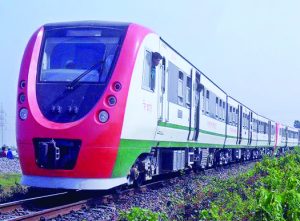The outcome of environment friendly transport system is very important issue in the current developmental aspects as transportation is an integral part in our day to day life irrespective of gender, age and class of economy.
Now a day’s transport systems are very key issue for economic development for a rapid growing developing country like Bangladesh. Transport system integrated with sustainability issue, environmental issue, safety issue and social sustainability issue etc. Bangladesh Railway is providing environment friendly transport system to the nation.
Bangladesh has made important gains in the fight against poverty. Derided as a basket-case only three decades ago, Bangladesh today is definitively out of the shadow of famine. Uniquely for a country facing an extremely vulnerable ecology, Bangladesh has established a credible record of sustained growth within a stable macroeconomic framework. At a comparatively low level of development, it has also earned the distinctions of a major decline in population growth rate and of graduating to the medium human development group of countries by UNDP’s ranking.
Sustained reform actions are on the card to enhance the contribution of railways to the economy and contain the adverse budgetary impact of its operations. The reconstruction of BR including corporatization and commercialization, and private participation are critical to develop the sector and improve efficiency of services. Linking Bangladesh Railway with the railways of neighboring countries through strategic partnership has a high potential for economic growth, poverty reduction and commercial viability of the sub-sector.
Bangladesh should build on the synergies of growth and poverty alleviation, raising the productivity of the poor while instituting reforms that could promote the sectors of highest efficiency. It is important to recognize that there is a close relationship between the growth in rail freight and economic growth, which is measured by GDP. As such, the growth of the economy will have direct impact on transport demand in Bangladesh. From a sector perspective, the recent GDP growth rate is characterized by incremental growth of industry and services. The economy has undergone a major structural change over the last 25 years.
Increase of passenger carriages implies to increase of passenger carried by train per year as well as reduction of road traffic which inherently implies to reduction accidents caused in road traffic and reduction of traffic congestion in road (i.e. saving valuable time of people which no longer can be ignored as time is money now).
Public transport should be prioritized. The noise and air pollution should be taken into account when designing and implementing public transport system. In recent years, environmentally friendly public transport relies on a green transport system for example green buses, bikes, taxies, trains. Green transport reduces people’s dependency on conventional fuel use in their vehicles and decreases pollution in terms of greenhouse gas emissions. In terms of greening the transport system research shows that dependency on cars have to be reduced, for this environmentally sound public transport system has to be emphasized. For being an environmentally friendly public transport system Rail is the most effective.
The major cause of the Green House Gas (GHG) impact of the rail investment programmed is towards mode-shift from high emitting transport means towards low emitting transport means. The mitigation impact is a resultant of differential GHG emission factors per passenger kilometer and ton kilometer of rail versus road transport. A report of Nationally Accepted Mitigation Action (NAMA) shows that for bus emission is 36 gCO2 per passenger Kilometer whereas for train it is 12 gCO2 per passenger Kilometer. On an average broad gauge passenger carriages have capacity to carry 80 passengers. In Bangladesh one carriage travels on an average 350 kilometer per day. Economic life of passenger carriages is 35 years. In 35 years if we consider 200 broad gauge passenger carriages, it willl be able to earn (200*35*365*350*80 =71540000000) 7154 crore passenger kilometer. For this train passenger kilometers emission will be (7154 crore*12=85848 crore gCO2) 85.85 crore KgCO2 or 858500 ton CO2 . To earn same passenger kilometer by bus emission will be (7154 crore*36=257544 crore gCO2) 257.54 crore KgCO2 or 2575400 ton CO2. Railway means of transportation will save (257544-858500=) 1716900 ton CO2. That is 200% less than road traffic. A course named “Business and Climate Change” gives a ballpark figure for carbon’s financial impact on the standard and poor’s, shows that average price per ton of Carbon dioxide (CO2) is 20 US Dollar. Railway transportation can save (1716900X20 = 34338000 US Dollar =) 34.34 million US Dollar by usage of 200 Broad Gauge Passenger carriages in 35 years.
From the above discussion it is clear that major portion of the green house gas emission is coming from road transport. The percentage will increase day by day if we are not concern to adapt policies for increase the railway transport in Bangladesh. Without proper railway network system it is difficult to introduce sustainable transport system in Highly dense populated country like Bangladesh. We had to take initiative with intensify efforts to increase funds for finance in the field of environmental friendly transport system that means in Railway sector.











